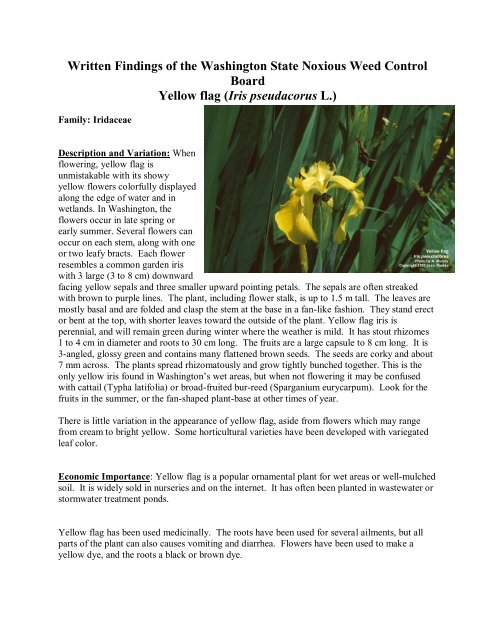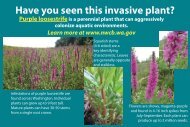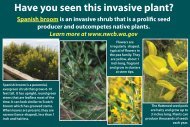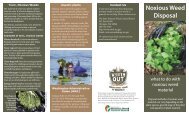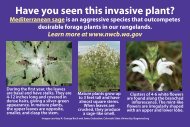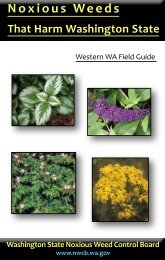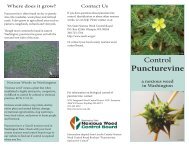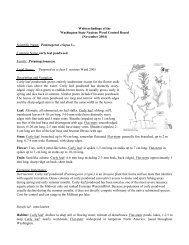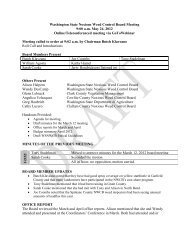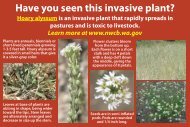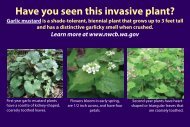Iris pseudacorus L - Washington State Noxious Weed Control Board
Iris pseudacorus L - Washington State Noxious Weed Control Board
Iris pseudacorus L - Washington State Noxious Weed Control Board
Create successful ePaper yourself
Turn your PDF publications into a flip-book with our unique Google optimized e-Paper software.
Written Findings of the <strong>Washington</strong> <strong>State</strong> <strong>Noxious</strong> <strong>Weed</strong> <strong>Control</strong><br />
<strong>Board</strong><br />
Yellow flag (<strong>Iris</strong> <strong>pseudacorus</strong> L.)<br />
Family: Iridaceae<br />
Description and Variation: When<br />
flowering, yellow flag is<br />
unmistakable with its showy<br />
yellow flowers colorfully displayed<br />
along the edge of water and in<br />
wetlands. In <strong>Washington</strong>, the<br />
flowers occur in late spring or<br />
early summer. Several flowers can<br />
occur on each stem, along with one<br />
or two leafy bracts. Each flower<br />
resembles a common garden iris<br />
with 3 large (3 to 8 cm) downward<br />
facing yellow sepals and three smaller upward pointing petals. The sepals are often streaked<br />
with brown to purple lines. The plant, including flower stalk, is up to 1.5 m tall. The leaves are<br />
mostly basal and are folded and clasp the stem at the base in a fan-like fashion. They stand erect<br />
or bent at the top, with shorter leaves toward the outside of the plant. Yellow flag iris is<br />
perennial, and will remain green during winter where the weather is mild. It has stout rhizomes<br />
1 to 4 cm in diameter and roots to 30 cm long. The fruits are a large capsule to 8 cm long. It is<br />
3-angled, glossy green and contains many flattened brown seeds. The seeds are corky and about<br />
7 mm across. The plants spread rhizomatously and grow tightly bunched together. This is the<br />
only yellow iris found in <strong>Washington</strong>’s wet areas, but when not flowering it may be confused<br />
with cattail (Typha latifolia) or broad-fruited bur-reed (Sparganium eurycarpum). Look for the<br />
fruits in the summer, or the fan-shaped plant-base at other times of year.<br />
There is little variation in the appearance of yellow flag, aside from flowers which may range<br />
from cream to bright yellow. Some horticultural varieties have been developed with variegated<br />
leaf color.<br />
Economic Importance: Yellow flag is a popular ornamental plant for wet areas or well-mulched<br />
soil. It is widely sold in nurseries and on the internet. It has often been planted in wastewater or<br />
stormwater treatment ponds.<br />
Yellow flag has been used medicinally. The roots have been used for several ailments, but all<br />
parts of the plant can also causes vomiting and diarrhea. Flowers have been used to make a<br />
yellow dye, and the roots a black or brown dye.
It will sicken livestock if ingested, and is generally avoided by herbivores (although muskrats<br />
will eat the rhizomes). Contact with the resins can cause skin irritation in humans.<br />
Yellow flag is listed on invasive species lists in Vermont, Virginia, Connecticut, and<br />
Massachusetts. It is also considered invasive in New Zealand and Australia. The Pacific<br />
Northwest Exotic Pest Plant Council lists it as ‘A-2 Most Invasive-Regional’ (highly to<br />
moderately invasive but still with a potential to spread).<br />
Geographic Distribution: Yellow flag is native to Europe, Great Britain, North Africa and the<br />
Mediterranean region. It has been introduced in temperate areas nearly world wide and occurs<br />
throughout the United <strong>State</strong>s except in the Rocky Mountains. It is found in wet areas throughout<br />
<strong>Washington</strong>, though it appears to be most common near developed areas.<br />
Habitat: Yellow flag grows in temperate<br />
wetlands (to 68 N in Scandinavia). It is<br />
found on both sides of the Cascades in<br />
wetlands and along the margins of lakes and<br />
slow-moving rivers. It will grow in water to<br />
.25 meters deep, though is most common in<br />
very shallow water or mud. It will tolerate<br />
drying and anoxic sediment and is also<br />
tolerant of at least some salinity, as it is<br />
found in brackish marshes in its native<br />
range. It is also tolerant of high soil acidity,<br />
occurring from pH 3.6 to 7.7. It does well<br />
in nutrient rich conditions, and has a high<br />
nitrogen requirement. It prefers part shade<br />
or full sun exposure.<br />
History: Yellow flag is native to Europe,<br />
the British Isles, North Africa and the<br />
Mediterranean. It is a very popular garden<br />
plant for wet or very well mulched soil, and<br />
has been introduced as an ornamental<br />
throughout the world. It was first collected<br />
Wetland in Western <strong>Washington</strong> (by Eric Stockdale)<br />
in North America in 1911 in Newfoundland,<br />
and was established in British Columbia by<br />
1931. The earliest collection in <strong>Washington</strong> is from Lake McMurray in Skagit County in 1948.<br />
It has also been used to control erosion, and is known to take up metals and nutrients in waste<br />
water treatment facilities.<br />
Growth and Development: Yellow flag dies back in harsh winter conditions, but the rhizomes<br />
will overwinter. In spring the long leaves and flower stalks regrow from the rhizomes and<br />
flower by late spring or early summer. The rhizomes spread to form dense stands that exclude
native wetland species, including typically aggressive species such as Typha latifolia (common<br />
cattail).<br />
Reproduction: Yellow flag spreads by rhizomes and seeds. Up to several hundred flowering<br />
plants may be connected rhizomatously. Rhizome fragments can form new plants if they break<br />
off and drift to suitable habitat. The flowers are pollinated by humble-bees and long-tongued<br />
flies.<br />
Seed germination is not light dependent, needs temperatures above 15 C and is most successful<br />
at temperatures of 20 to 30 C. Germination is increased by scarification. Submersed seeds<br />
will not germinate.<br />
Response to Herbicides: resistant to terbutryne. Cutting followed by treatment with glyphosate<br />
using a dripless wick has been suggested.<br />
Response to Cultural Methods: Seeds germinate and grow well after being burned in late<br />
summer. Also readily resprouts from rhizomes after burning.<br />
Response to Mechanical Methods: If pulling or digging yellow flag care should be used to<br />
protect the skin as resins in the leaves and rhizomes can cause irritation. Because rhizome<br />
fragments can grow to form new plants, care must be taken to collect all fragments.<br />
Biocontrol Potentials: No biological control work has been done for yellow flag iris.<br />
References<br />
Boule, M. K. Brunner, J. Malek, F. Weinmann, V. Yoshino. Wetland Plants of the Pacific<br />
Northwest. US Army Corps of Engineers, Seattle. 85 pp.<br />
Correll, D.S. and H.B. Correll. 1975. Aquatic and Wetland Plants of Southwestern United<br />
<strong>State</strong>s Vol 1. Stanford University Press, Stanford, CA. 856 pp.<br />
Guard, B.J. 1995. Wetland Plants of Oregon and <strong>Washington</strong>. Lone Pine Publishing, Redmond,<br />
WA. 239 pp.<br />
Websites:<br />
Good factsheet on the University of Florida Center for Aquatic and Invasive Plants (with many<br />
additional listed references): http://plants.ifas.ufl.edu/seagrant/iripse2.html<br />
GardenBed.com (http://plants.gardenbed.com/35/3405_med.asp)<br />
USGS http://nas.er.usgs.gov/plants/docs/ir_pseud.htm


